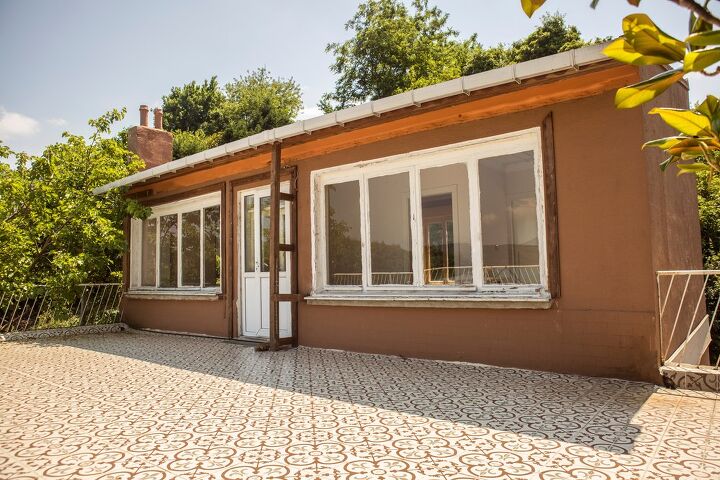Should Window Weep Holes Be Covered?

Homeowners come across many new discoveries about their house as time goes on. Sometimes it feels like you learn new things about your home every day.
One example of this is weep holes. If you’ve never heard of them, you’re not alone. Many homeowners never knew what they were before they noticed them and were not sure of their purpose.
If you don’t know what weep holes are used for, your first instinct might be to cover it. However, you should never cover a window weep hole. Covering the hole with caulk or paint can cause your window to leak, and ultimately lead to rot and other unpleasant consequences.
Do You Need a Window and Door Contractor?
Get free, zero-commitment quotes from pro contractors near you.

What Is A Window Weep Hole?
A weep can be defined as a small opening that lets water drain from a cavity between the exterior and an internal wall. They can be used in several different instances, such as brick walls, curtain walls and most commonly, windows. For the purpose of this article, we will discuss window weep holes specifically.
Window weep holes are built into the bottom of window frames. These holes are made to drain water that can collect in your window tracks. They are called “weep” holes because precipitation “weeps” out through the small opening.
You know how when it rains, sometimes you have to rush to close the windows to keep the rain out? When you close them, often you will still have water trapped on the inside in the windowsill. The weep hole outside allows this water to drain.
Why Are Window Weep Holes Important?
These tiny details serve a huge function in protecting your windows and your home from outside elements. When water leaks into your windows, it can seep through the wood on the sill and cause the window to rot. When this happens, it can get expensive to repair the damage.
Additionally, lack of weep holes makes your window vulnerable to insect damage as well as mold contamination. If you notice that your window frames do not have these holes, there are ways to install them yourself.
How Can I Make My Own Window Weep Holes?
If you do not have weep holes and prefer not to spend the money on hiring someone else to install them, you might be able to do it yourself.
Installing weep holes in your windows is a simple process. Just drill a pair of ¼-inch holes through the bottom of the window frame. Some tips to keep in mind:
- The holes should be about 1-2 inches from the corners of the frame.
- The drill needs to go all the way through the frame, into the space between the storm and primary window (if you have storm windows)
- Drilling into the windowsill surface could compromise the wood, causing issues with rot
If you are not comfortable doing this yourself or are not confident about drilling into the correct area, contact a professional.
Can I Cover The Weep Holes?
There are many homeowners who are uninformed about the necessity of clear weep holes. A lot of people do not realize they are there or cover them with caulk to fill the hole.
Some people might think that covering them makes sense to keep the hot or cold air in. It is logical to see a hole in your window and be concerned about unwanted weather coming in.
However, most storm window manufacturers anticipated this issue and include small flaps over the hole. These flaps allow water to exit, but prevent water from coming in. Also, the holes are installed at an angle, so that air cannot flow directly into the window.
Therefore, it is not a good idea to cover window weep holes. The benefits of the holes far outweigh any potential disadvantages. Clogged weep holes can only be detrimental to the integrity of your windows, and lead to expensive repairs.
What Should I Do If My Window Weep Holes Are Clogged?
Now that we have established the necessity of weep holes, let’s talk about how to keep them open. If you notice that the weep hole is clogged, you should clear it out as soon as possible. When it comes to cleaning these out, there is good news and bad news.
The bad news is that most people don’t notice their weep holes are clogged until their windows start leaking. This will often happen during a heavy rainfall, when they need to stop the leaking right away.
Fixing Clogged Weep Holes
The good news is that it’s a very simple fix, and it likely won’t cost you a dime. Once you locate the weep hole, clean out any debris you see. More than likely you will find things like leaves, dead insects or small twigs inside.
Next, take a cotton swab and clean out the hole. If you have a can of compressed air on hand, a quick spray of air will clean out the hole even faster.
Now that the hole is clear and free of debris, it should be able to do its job properly. You can sit back, relax and enjoy your dry windows (and floors) again.
How Do I Know If My Weep Holes Are Working Properly?
Now that you know how important window weep holes are, you may be wondering how to ensure yours are functioning correctly. This is an easy process and can tell you in seconds whether you have any blockage.
To make sure your window weep holes are in good shape, just spray the outside of the window with your garden hose. When you spray the window, you should see a stream of clear water exiting the hole. If not, your weep hole is likely clogged, and you can follow the steps mentioned earlier to clean it.
Inspecting The Weep Holes
It is a good idea to check your weep holes periodically to ensure they are draining properly. If your area has a rainy season, be sure to check them before the rain hits. This will avoid unpleasant leaks in your house.
Regular cleaning of your windows will also help keep your window weep holes clear. Whenever you clean the glass on your windows, get into the habit of also clearing out the tracks on the sill. Making sure the tracks are free of debris and dust will reduce the chance of clogs.
Are You Worried About Pests Entering Your Weep Holes?
Most people want to plug their weep holes because they’re worried about bugs and pests entering their homes. Some weep holes are large enough for this to happen. So, if it’s not a good idea to plug your weep holes, what can you do to deter the pests? What you can do instead of painting them or gluing them shut is plug them with stainless steel wool.
The stainless steel wool helps keep the pests from infiltrating your home while allowing water to still run out of the weep holes. The holes can continue to breathe while you keep bugs out of your home.
As a matter of fact, many professionals use stainless steel wool in the weep holes to protect the exterior so that bugs cannot get in. The stainless steel wool holes are large enough to let water flow out, but not large enough to leg bugs come in.
Related Questions
What can I do about window rot?
Wood rot happens when wood gets wet and stays wet. It is important to fix rot the moment you notice it. The solution depends on the severity of the rot. If you only find one or two pockets of rot, you can try to clean it out yourself. If the rot is more extensive, you’ll have to replace exterior boards. The best option, in this case, is to hire a professional.
Why is my window leaking?
When you find the water coming in through your window, check your weep holes first. Clogged weep holes are a common cause of window leaking and are easy to fix. If this doesn’t work, check the seal on your window.
If the glass pane is not strongly sealed to a rubber/vinyl gasket in the frame, you’ll have to reinforce the seal with caulk. If that doesn’t help, check the frame seal outside. If all else fails, it’s time to contact a professional.
Do all windows have weep holes?
Yes, all different types of windows contain weep holes. The weep holes that are in vinyl windows are similar to the ones in aluminum and wooden frames, as they all work the same. The vinyl windows contain small vents that help keep water from entering the building by pushing the accumulated water through the weep holes.
Do You Need a Window and Door Contractor?
Get free, zero-commitment quotes from pro contractors near you.

Wrapping Up
To review, weep holes are a necessary drainage system for your windows and should never be covered. Doing so can lead to window rot and clogs. If you suspect that yours are not working properly, you should check for clogs.
Be sure to inspect your weep holes regularly to prevent blockage before it happens. Regular cleaning of the windowsills will also keep the drainage system flowing as intended.

We are a team of passionate homeowners, home improvement pros, and DIY enthusiasts who enjoy sharing home improvement, housekeeping, decorating, and more with other homeowners! Whether you're looking for a step-by-step guide on fixing an appliance or the cost of installing a fence, we've here to help.
More by Upgraded Home Team













![10 Best Zero Turn Mowers – [2022 Reviews & Ultimate Buyer's Guide]](https://cdn-fastly.upgradedhome.com/media/2023/07/31/9070522/10-best-zero-turn-mowers-2022-reviews-ultimate-buyer-s-guide.jpg?size=350x220)
![10 Best Scroll Saws for 2022 [Ultimate Reviews & Buyer's Guide]](https://cdn-fastly.upgradedhome.com/media/2023/07/31/9070684/10-best-scroll-saws-for-2022-ultimate-reviews-buyer-s-guide.jpg?size=350x220)












